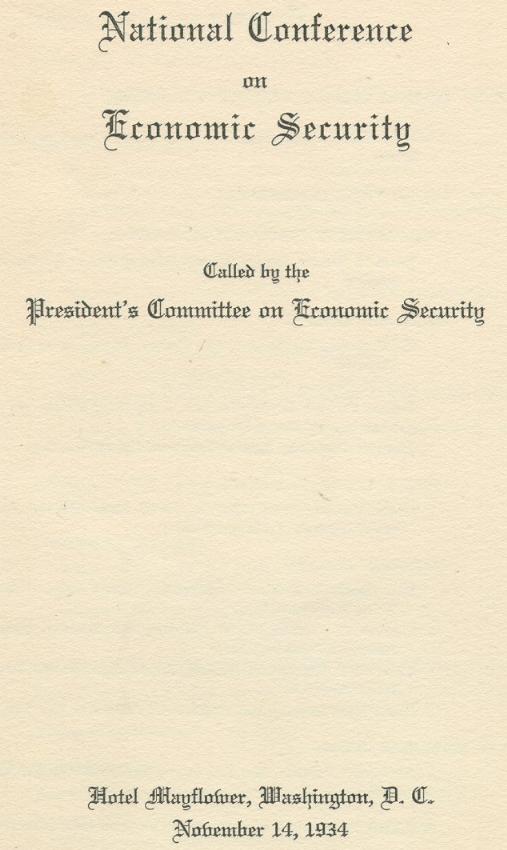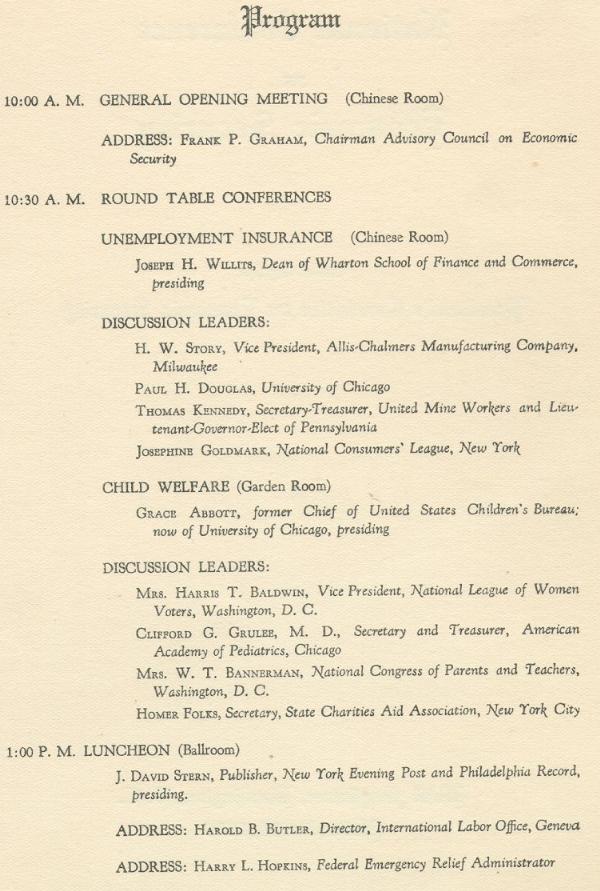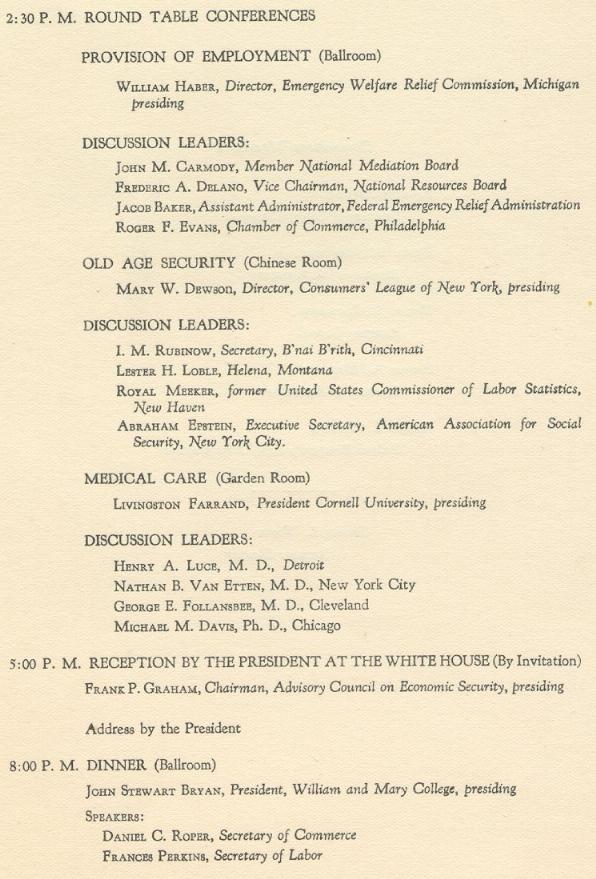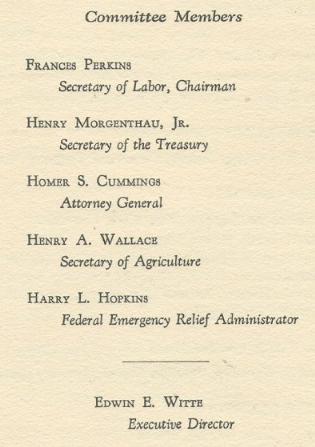National Conference on Economic Security
The CES-
By early 1934 President Roosevelt had concluded the troubled nation needed to develop a social insurance system to prevent in the future the kind of destitution it was experiencing in the Great Depression. On June 8th he sent a special Message to Congress announcing his intentions and stating: "Next winter we may well undertake the great task of furthering the security of the citizen and his family through social insurance . . . I am looking for a sound means which I can recommend to provide at once security against several of the great disturbing factors in life--especially those which relate to unemployment and old age."
The President put this promise into action by issuing an Executive Order (#6757, dated June 29, 1934) creating the Committee on Economic Security (CES) to develop the administration's legislative proposal. The CES was comprised of five cabinet-level officials, chaired by FDR's Secretary of Labor, Frances Perkins ( the other members were Secretary of the Treasury Henry Morgenthau Jr.; Attorney General Homer S. Cummings; Secretary of Agriculture Henry A. Wallace; and Harry L. Hopkins, the Federal Emergency Relief Administrator). The CES was staffed by a Technical Board of 21 government experts drawn from various federal agencies.
The President also specifically requested that an Advisory Council of prominent representatives of the public be formed to advise the CES. The Advisory Council had 23 members and was chaired by Frank P. Graham, the President of the University of North Carolina. (See list.)
Since federal social insurance was in many ways an unprecedented innovation, much of the technical work of the CES involved researching social insurance in Europe and documenting the economic circumstances of America at that critical time. Eventually, the CES would issue a massive 13-volume study of the issue, along with a 50-page summary Report to The Congress, and a detailed legislative proposal. The Report to the Congress and the administration's legislative proposal were sent to Capitol Hill in early January 1935.
The CES' Executive Staff Director, Professor Edwin Witte of the University of Wisconsin, was the administration's lead witness in the Congressional hearings held on the bill. Witte presented the Report of the CES and testified about it at length. He also participated in executive sessions of the Committees, advising the Congress on the various proposals for amending the bill.
The CES was really the key to the development of Social Security in America in the crucial months between June 1934 and January 1935. During this time all of the ground-breaking analysis, program design, and legislative drafting was done. By the time the administration's bill was introduced in the Congress, the nation was presented with a comprehensive, rationalized, detailed proposal for a social insurance system adapted to America's circumstances. The most important and active member of the CES was Frances Perkins, who was both a major conceptual designer of the program and its political driving force.
The National Conference-
President Roosevelt also specifically directed Secretary Perkins to convene a National Conference on Economic Security at which outside experts and the general public could meet with the CES and the Advisory Council and offer their input in the development of the legislative proposal. This Conference was organized by the CES and was held on November 14, 1934 at the Mayflower Hotel in Washington, D.C.
In addition to the CES and the Advisory Council, the meeting was attended by 150 invited guests from around the nation who were considered experts in the field. The meeting was also open to the general public and was very well attended.
The format of the Conference was that meetings took place at the Mayflower throughout the day. In the late afternoon, President Roosevelt held a separate meeting at the White House for the CES, the Advisory Council and the 150 invited guests. In the evening the group returned to the Mayflower for a dinner event which was again open to the public.
The National Conference was the first time that government officials, academic experts and civic leaders, and the general public were convened to discuss Social Security. In effect, this was the first town-hall forum on Social Security in the nation's history.
Members of the 1934 Advisory Council |
|
| Frank P. Graham | President University of North Carolina, Chapel Hill, N.C.; Chairman. |
| Paul Kellogg | Editor The Survey, New York City; Vice Chairman. |
| Gerald Swope | President General Electric Co., New York City. |
| Morris E. Leeds | President Leeds & Northrup, Philadelphia, Pa. |
| Sam Lewisohn | Vice President Miami Copper Co., New York City. |
| Walter C. Teagle | President Standard Oil Co., New Jersey, New York City. |
| Marion B. Folsom | Assistant Treasurer, Eastman Kodak Co., Rochester, New York. |
| William Green | President American Federation of Labor, Washington, D.C. |
| George M. Harrison | President Brotherhood of Railway and Steamship Clerks, Cincinnati, Ohio. |
| Paul Scharrenber | Secretary-Treasurer California State Federation of Labor, San Francisco, California. |
| Henry Ohl, Jr. | President Wisconsin State Federation of Labor, Milwaukee, Wisconsin. |
| Belle Sherwin | Former President National League of Women Voters, Washington, D.C. |
| Grace Abbott | University of Chicago, and former Chief, United States Children's Bureau. |
| Raymond Moley | Editor, Today, and former Assistant Secretary of State. |
| George H. Nordlin | Chairman Grand Trustees, Fraternal Order of Eagles, St. Paul, Minn. |
| George Berry | President International Printing Pressmen and Assistant's Union, Tennessee. |
| John G. Winant | Governor, New Hampshire. |
| Mary Dewson | National Consumers League, New York City. |
| Louis J. Taber | Master, National Grange, Cleveland. |
| Mnsgr. John A. Ryan | National Catholic Welfare Conference, Washington. D.C. |
| Helen Hall | President, National Federation of Settlements and Director of the Henry Street Settlement, New York City. |
| Joel D. Hunter | General Superintendent, United Charities of Chicago. |
| Elizabeth Morrissey | Notre Dame College, Baltimore, Maryland. |



